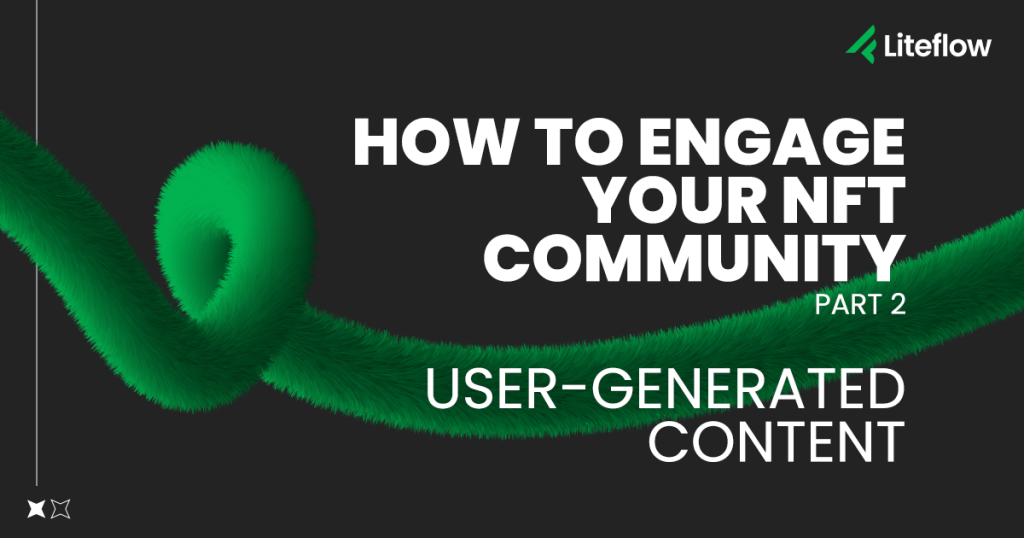How to Engage Your NFT Community – Part 2: User-generated Content

39% of internet content consumed by Americans is user-generated content (UGC). Web2 platforms like YouTube, Instagram, and TikTok provide home-grown creators with the tools to release engaging content. These tools are why the creator economy is expected to reach a $104.2 billion valuation this year, with $800 million in venture capital being invested into UGC year over year.
Web3 projects would be wise to learn from trends and tech that have driven UGC in Web2. Web3 projects can replicate UGC’s massive success and scale as a strategy for user acquisition and retention. There is an argument that Web3 is even better suited for UGC because of the ease of monetization and importance that communities have in this rapidly growing space.
Empowering Communities
Communities are the heart of Web3 projects, helping build awareness and raise capital. This dynamic differs from Web2, where similar financial incentives through ownership don’t exist, and users are the product. In Web3, communities control much of the power and are seeking projects that acknowledge this by providing an empowering experience instead of extracting value from users.
NFT projects that want to empower their communities should be looking toward growing UGC directly from members based on your brand’s content. There is potential to deliver more value than just the initial NFTs, inspiring engagement and offering revenue opportunities for creators within your community. Fan art, derivatives, and other brand-inspired content can be transformative for the brand and the community.
Projects that create an ecosystem for members to mint and trade NFTs are growing the value of their brand. Not only will more people be introduced to you through this content, but you will also showcase existing community members, allowing them to create, monetize and resell their work. This process creates exclusive opportunities for monetization.
Considering IP Rights and CC0
Businesses that allow for the creation and monetization of UGC must consider how IP impacts the potential scope. A CC0 classification is a great solution to remove the headache of protecting IP by eliminating exclusivity and allowing anyone to create content using your work. This opens the door to a range of UGC possibilities without heavily guarded IP legal concerns.
For some projects, this classification might need to be narrower. An alternative is the issuing of exclusive IP rights to holders of your NFT collection, rewarding members with the ability to use IP and monetize their UGC. An example of this would be Doodles, who allows holders to sell merchandise with their NFT for up to $100k of revenue, at which point a special licensing deal is required.
Doodles takes this a step further by aiming to protect its brand reputation. According to their terms of service, “Users shall not use the Doodles Licensed Materials in any way that could be construed as being adverse or derogatory to the image of Doodles or any of its subjects featured in the NFTs.” This is how Doodles is empowering their community to create UGC, while protecting their own brand in the process.
Building Community-Powered Web3 Ecosystems
Most NFT projects rely on existing platforms to fuel engagement. Opensea, Discord and Twitter provide a space to create as a community, but why sacrifice your engagement to external platforms? A dedicated ecosystem for community storytelling and UGC taps into the expanding creator economy and unlocks new channels for engagement, revenue, and growth.
Most projects direct their users to third-party platforms after mint, pushing activity elsewhere and losing an opportunity to boost engagement. We are firm believers that every serious NFT collection will soon have a dedicated marketplace. This is because there is much more value in delivering a unique branded experience than relying on other platforms to do your job for you.
After all, it is only through managing your community’s platform that projects can truly offer a place to create, trade and explore UGC. Without this platform, projects become reliant on other solutions and lose control of what their community can access.
Despite all of Web2’s shortcomings, there are many lessons to be learned from the success of Web2 companies, especially around UGC. UGC has fueled an entire generation of content on the internet, empowering users to create experiences around their favorite brands and franchises. This model can be expanded on using Web3 infrastructure, shifting the dynamic to benefit creators and their communities over the big tech platforms that profit off of the content being created.
At Liteflow, we bring the flexibility of building web3 projects according to your needs while helping you own your revenue model for the internet’s next era. If UGC is something you’d like to inspire from your community, let’s bring those ideas to life! Reach out to us at Liteflow, and schedule a call with one of our experts.